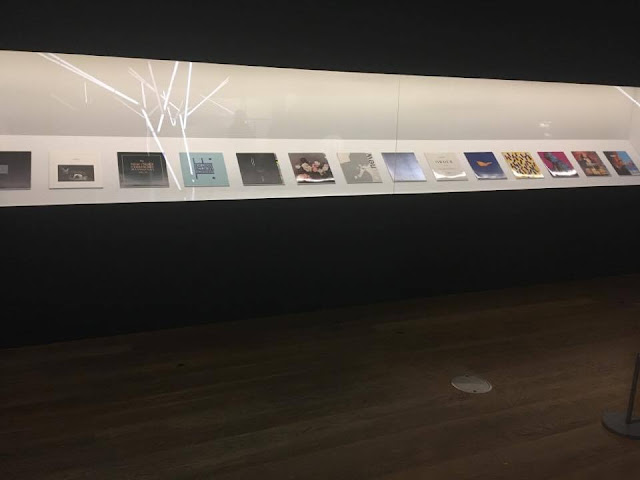This book seems to be absolutely perfect for the direction I want my COP to lead. In a really specific way, it is discussing the principles of the alluring nature of analogue and also the influence of digitisation on production and society. This ties in perfectly with the theorists ideologies I studied during COP1 and has some beautiful quotes which I wish to include in my analysis's for COP2.
I have begun this reading over the summer because I know that it will take me a long time to read this book and I have opportunity to chip away at it. I want to read it and have time to process it all so that I can begin COP2 with some research so I can get stuck in straight away. As I have learnt through COP1, my journal and essays are very much structure around quotes I drew from my research so I have done the same with this... it makes the information more accessible and easier to analyse. I have also learned to add page numbers to everything from the hassle of referencing for COP1.
‘Vinyl: The Analogue Record in the Digital Age’
Dominik Bartmanski and Ian Woodward
‘the ‘outside’ defines the ‘inside’’ p2
‘material form being something special and co-productive of even our deepest
sentiments’ p2
‘treating the analogue record not only as a musical record but also as a
record of culture’
p2
‘vinyl’s cultural biography has been a transformation of something
presented as irreplaceable (…), to something that gets discarded as soon as
more profitable and convenient stuff comes our way’ p2
‘what social scientists and our interviewees alike call the aura of
objects, or the ‘magic of things’, or the ‘power of appearances’ p2
‘over powering extent to which our culture is nowadays mediated that
sometimes gives rise to certain romantic ideas of ‘direct’ contact with art or
belief in ‘pure aesthetic substance’ p3
‘the wholesale digitalization of culture, not just of music, made us
sensitive to both what we have gained and to what we have lost, or may be
losing, as we are rushed to embrace perennially upgradeable technologies’ p3
‘often things reveal their true value only when they are displaced’ p3
‘the digital seemed to be the kiss of death to the analogue’ p4
‘nowadays the idea of the ‘analogue’ record makes sense again, and it is
not despite but partly because of digitalization’ p4
‘it is easier to see vinyl as the ‘sacred’ format when virtual files
become the mundane ‘everyday’ format’ p4
‘the analogue record is one of the landmark elements of the modern media
scape’ p5
‘connecting artists and their audiences via the work of other artists
and engineers’ p5
‘’while records are like books and photographs in their capacity to
create cultural archives, they may also be artistic objects in their own right’
p5
‘you do not only hear music, you are in direct visual contact with music’
p5
‘the analogue record may be approached as a kind of Gesamtkunstwerk – a total piece of art’ p5
‘Each outstanding medium is capable of generating its own culture, and
every culture sustains its iconic objects’ p6
Regis Debrey ‘No tradition has come about without being an invention of
recirculation of expressive marks and gestures… and no new dimension of
subjectivity has formed without using new material objects’
‘records are in principle available to anyone. It is a truly public
medium for private use’ p6
‘the mid-200s was the time when vinyl’s presence on the market reached
its all time nadir’ p7
‘your dealer can demonstrate a varied line of Columbia phonographs,
styled to enhance the decorative scheme of your home’ p11
‘For quite some time the sleeves of Columbia LP’s featured carefully
curated covers’ p11
‘Vinyl had certainly not lost its importance and aura to the artists
though, especially those who committed to the ethos of new independent scenes
such as punk in the UK and Europe’ p15
‘the nascent digitalisation revealed the possibility of delivering a
remarkably ‘cleaner’ sound, one free of any unwanted sounds and imperfections
of vinyl when delivered on CD’ p16
‘Doing away with the vinyl meant, however, that the characteristic ‘warmth’
of analogue sound was good too’ p16
‘the digital solution resembled throwing out the baby with the bath
water’ p17
‘while the golden age of vinyl meant a giant leap of popular music, it
was the shift to the digital that meant the golden age for the popular music
industry’ p19
‘the only music carrier worth
owning and collecting’ p20
1900 Georg Simmel “The necessary detour to the attainment of certain
things is often the occasion, often also the cause, of regarding them as
valuable” p20
Antonie Hennion called ‘discomophosis’ – ‘collecting the actual discs’
p20
‘Vinyl as a medium and a practice is an element of style in the world of
music’ p23
‘the treasure trove of musical traditions’ p25
‘it is an ‘organic’ object in a world increasingly facilitated by all
kinds of artificial intelligence’ p30
Hegel (music)’cancels it as objective and does not allow the external to
assume in our eyes a fixed existence as something external’ p30 (47)
‘The digital and virtual brought music somewhat closer to its abstract ‘pure’
state. Vinyl, on the other hand, grounds it in our concrete experiences, in actual
spaces of our existence’ p32
Jacues Ranciere ‘the contemporary practices of deejaying, sampling and remixing, which multiply the ‘unique copies’’
p33 (51)
Robert Henke ‘The medium is something which serves as a focus point. It’s
a singular thing that accumulates.’ P35
‘Ours is a world of multiple media in which form tends to follow function.
(…) the reverse tendencies have also been the case: function follows form’ p35
Terence McDonnell affordances ‘the
latent set of possible actions that environments and objects enable are
relationally tied to the capabilities of the person interacting with that
object’ p37



























